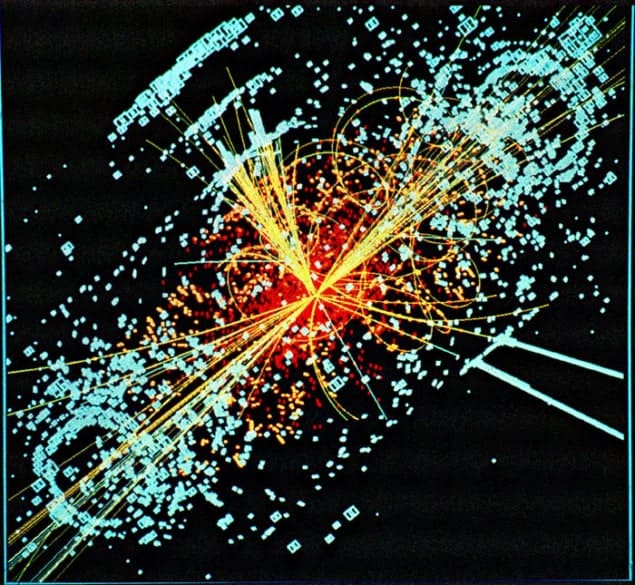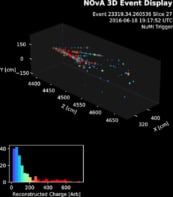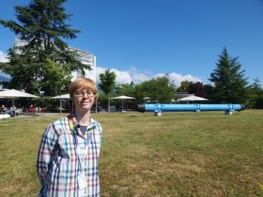
The first results on supersymmetry from the Large Hadron Collider (LHC) have been analysed by physicists and some are suggesting that the theory may be in trouble. Data from proton collisions in both the Compact Muon Solenoid (CMS) and ATLAS experiments have shown no evidence for supersymmetric particles – or sparticles – that are predicted by this extension to the Standard Model of particle physics.
Supersymmetry (or SUSY) is an attractive concept because it offers a solution to the “hierarchy problem” of particle physics, provides a way of unifying the strong and electroweak forces, and even contains a dark-matter particle. An important result of the theory is that every known particle has at least one superpartner particle – or “sparticle”. The familiar neutrino, for example, is partnered with the yet-to-be discovered sneutrino. These sparticles are expected to have masses of about one teraelectronvolt (TeV), which means that they should be created in the LHC.
In January the CMS collaboration reported its search for the superpartners of quarks and gluons, called squarks and gluinos, in the detector. If these heavy sparticles are produced in the proton–proton collisions, they are expected to decay to quarks and gluons as well as a relatively light, stable neutralino.
SUSY’s answer to dark matter
The quarks and gluons spend the energy that was bound up in the sparticle’s mass by creating a cascade of other particles, forming jets in the detector. But neutralinos are supersymmetry’s answer to the universe’s invisible mass, called dark matter. They escape the detector unseen, their presence deduced only through “missing energy” in the detector.
CMS physicists went hunting for SUSY in their collision data by looking for two or more of these jets that coincide with missing energy. Unfortunately, the number of collisions that met these conditions was no greater than expected with Standard Model physics alone. As a result, the collaboration could only report new limits on a variation of SUSY called constrained minimal supersymmetric standard model (CMSSM) with minimal supergravity (mSUGRA).
ATLAS collaborators chose a different possible decay for the hypothetical sparticle; they searched for an electron or its heavier cousin, the muon, appearing at the same time as a jet and missing energy. ATLAS researchers saw fewer events that matched their search and so could set higher limits, ruling out gluino masses below 700 GeV, assuming a CMSSM and mSUGRA model in which the squark and gluino masses are equal.
Good or bad omens?
Many believe that these limits are not bad omens for SUSY. The most general versions of the theory have more than a hundred variables, so these subtheories simplify the idea to a point where it can make predictions about particle interactions. “It’s just a way to compare with the previous experiments,” says CMS physicist Roberto Rossin of the University of California, Santa Barbara. “No-one really believes that this is the model that nature chose.”
ATLAS collaborator Amir Farbin, of the University of Texas, Arlington, calls these first results an “appetiser” for the SUSY searches to be discussed at the March Moriond conferences in La Thuile, Italy. “At this point, we’re not really ruling out any theories,” he says.
At this point, we’re not really ruling out any theories Amir Farbin, University of Texas
Still, CMS scientists Tommaso Dorigo of the National Institute of Nuclear Physics in Padova, Italy, and Alessandro Strumia of the National Institute of Chemical Physics and Biophysics in Tallinn, Estonia, say that there is some cause for concern. Supersymmetry must “break”, making the sparticles much heavier than their partners. It stands to reason that this should happen at the same energy as electroweak symmetry breaking – the point where the weak force carriers become massive while the photon stays massless.
This is thought to occur in the vicinity of 250 GeV. “But the LHC results now tell us that supersymmetric particles must be somehow above the weak scale,” says Strumia.
Dorigo notes that although SUSY can allow for high sparticle masses, its main benefit of solving the hierarchy problem is more “natural” for masses near the electroweak scale. The hierarchy problem involves virtual particles driving up the mass of the Higgs boson. While supersymmetric particles can cancel this effect, the models become very complex if the sparticles are too massive.
John Ellis of CERN and King’s College London disagrees that the LHC results cause any new problems for supersymmetry. Because the LHC collides strongly interacting quarks and gluons inside the protons, it can most easily produce their strongly interacting counterparts, the squarks and gluinos. However, in many models the supersymmetric partners of the electrons, muons and photons are lighter, and their masses could still be near the electroweak scale, he says.
Benchmark searches
CMS collaborator Konstantin Matchev of the University of Florida, Gainesville, explains that new physics was expected between 1 and 3 TeV – a range that the LHC experiments have hardly begun to explore. In particular, he notes that of the 14 “benchmark” searches for supersymmetry laid out by CMS collaborators, these early data have only tested the first two.
“In three years, if we have covered all these benchmark points, then we can say the prospect doesn’t look good anymore. For now it’s just the beginning,” says Matchev.
But not everyone is optimistic about discovering SUSY. “We will get in a crisis, I think, in a few years,” Dorigo predicts, sceptical of the theory because it introduces so many new particles of which data presently show “no hints”. However, even though he would lose a $1000 bet, he says that he would still be among the first celebrating if the LHC does turn up sparticles.
The CMS and ATLAS results are available on arXiv.



